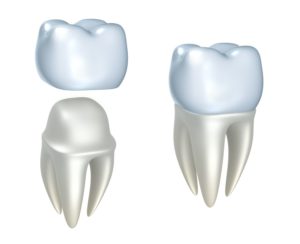If you sustain damage to one of your teeth, your dentist might suggest restoring its structure and preventing further harm by giving you a dental crown. This ceramic cap fits over the tooth, enhancing it and shielding it from external dental dangers.
Though you may look forward to the relief this treatment can provide, you might also feel nervous about undergoing dental work. You might feel more at ease in the dentist’s chair if you know what to expect from the procedure. To alleviate lingering dental fear, read on and learn about the four major steps to the dental crown treatment process.

What Happens When Receiving a Dental Crown?
Evaluating the Damaged Tooth
Before pursuing restorative dental treatment with a dental crown, your dentist will thoroughly examine the tooth in question. They will make sure you do not have other dental concerns that will require further treatments completed before they place a crown.
For instance, if you need root canal therapy, a dentist will do this procedure before giving you a crown. They will also make sure a crown will provide the best oral health benefits compared to other treatment options. This consult appointment makes for a great opportunity to ask any questions about what you can expect with this treatment.
Preparing the Surface of the Tooth
When you and your dentist decide to commit to treatment with a dental crown, the dentist will need to prepare the tooth. This involves shaving away a minute amount of tooth enamel to make room for the cap.
You will receive a local anesthetic that will numb the affected area so that you do not feel discomfort during this process. Once enamel is gone, it cannot regrow, so dentists consider a dental crown to be a permanent treatment.
Taking Dental Impressions
With the tooth prepared, your dentist will next take impressions of the tooth. This will be done with either a physical mold or digital imaging technology. Dentists use the impression to construct a custom-made dental crown that will fit comfortably and securely over your unique tooth.
They will factor in the size, shape, and color of your natural smile for the perfect finish. This process can take a few weeks. Your dentist can give you a temporary crown in the meantime. But your dentist may also use same-day CEREC crowns where applicable.
Securing the Cap Over the Tooth
Once your crown is ready, your dentist can place the dental crown over the tooth. The dentist will seal the crown into place with dental cement. The crown then acts as a shield for this tooth, ensuring plaque and bacteria cannot access it and cause further dental damage.
The durable material and secure fit ensure long-lasting restorative dental benefits. With proper care, your crown can remain over your tooth for fifteen years or more. You can chew and bite as you normally would, but be careful with hard and sticky food items.
